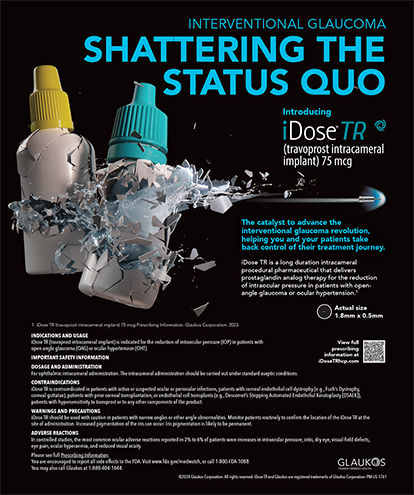Ocular surface disease (OSD) comprises the most commonly overlooked group of pathologies in the ophthalmic world. It affects up to 30% of the population over the age of 50 years1 and is a major factor in patients' dissatisfaction with laser refractive surgery and intraocular surgery utilizing premium IOLs. Treatment, unfortunately, still often may be an afterthought: artificial tear supplements or a recommendation for them is given to a patient as he or she leaves the clinic.
The only widely available medication to treat OSD in the United States is cyclosporine (Restasis; Allergen, Inc.), and this product was approved by the FDA back in 2002. Part of the difficulty in bringing new drugs to market reflects the challenge of diagnosing OSD: variability in patients' complaints and poor correlation with their clinical presentation.
OVERVIEW: THE CHALLENGE OF DIAGNOSIS
OSD is multifactorial. A healthy tear film relies on
- a properly functioning meibomian system to reduce the evaporation of tears
- a healthy conjunctiva (goblet cells, normal architecture) to produce aqueous and mucin
- proper eyelid position and architecture and the capacity for a complete, full blink to distribute the tear film over the entire ocular surface
Physicians often suspect OSD based on reported symptoms, including ocular dryness, discomfort, and irritation; feelings of grittiness; fatigue; and photosensitivity. Other complaints may include ocular pain or foreign body sensation, tearing or mucus discharge, transient blurring, symptoms that worsen later in the day, and contact lens intolerance.
Even after a complete history and a thorough slitlamp examination, the diagnosis may prove to be elusive. This frustration has led to the development of new diagnostic modalities to help clinicians identify and treat OSD.
DIAGNOSTIC TOOLS
Clinicians often use Schirmer testing as a measure of dry eye disease (DED), but results with this test are highly variable. They depend on day-to-day changes in the patient's hydration, local climate and temperature, and the tester him- or herself. Dyes such as lissamine green, rose bengal, and fluorescein help to identify areas of pathology, but the popularity of high-tech testing is growing (Figures 1-2).
Physicians can now evaluate the thickness and stability of the tear film's lipid layer with the Lipiview Ocular Surface Interferometer (TearScience, Inc.). This device optically grades the severity of the tear film disruption after it captures images. More advanced grades require more aggressive treatment. The Lipiflow Thermal Pulsation System (TearScience, Inc.) helps to treat obstructed meibomian glands, which are the primary cause of evaporative DED. (A lack of the lipid layer floating on the aqueous portion of tears allows for more rapid evaporation.) A soft, heated, rubber speculum places pressure on the meibomian glands and expresses meibum through the orifices at the lid margin; this process is performed on one eyelid at a time. The treatment is not covered by insurance and costs approximately $1,000 per eye. Alternatively, the physician can perform manual expression by rolling the eyelids between two cotton-tipped applicators or via the Arita Meibomian Gland Compressor (Katena Products, Inc.).
The use of optical coherence tomography (OCT) is widespread among ophthalmologists. This technology has been utilized to evaluate the layers of the retina. More recently, physicians are obtaining OCT scans of the anterior segment. High-resolution OCT can now be used to measure the thickness of the tear film and to serially evaluate this layer over time. The Keratograph (Oculus, Inc.) evaluates the cornea via keratometry and topography. New software to measure the height of the tear meniscus and look at tear breakup time is also available.
Measurements of tear film osmolarity are thought to be the most reliable means of diagnosing OSD. Osmolarity is elevated in both evaporative and aqueous-deficient DED, however, and this test does not allow clinicians to distinguish between the two entities. In addition, hyperosmolarity contributes directly to patients' signs and symptoms by changing the way tear film lipids and proteins interact with each other and by damaging epithelial cell membranes. The latter triggers inflammation and irritates corneal nerves. A physical property that correlates with osmolarity is electrical conductivity, which can be measured in nanoliter samples in the new TearLab Osmolarity System (TearLab Corporation). Requiring only several minutes to complete and with accurate results, the device is suitable for clinical settings.
Besides changes in osmolarity, the inflammatory marker matrix metalloproteinase (MMP)-9 is commonly found in ocular surface inflammation. The InflammaDry (Rapid Pathogen Screening Inc.; not available in the United States) determines the presence of MMP-9 in the tear film. Samples are taken from the inferior palpebral conjunctiva, and results are available in 10 minutes. Unfortunately, MMP-9 is not specific to DED.
CONCLUSION
It is to be hoped that newly available technologies and increased awareness will give rise to new treatment modalities for OSD in the near future. The goal is to improve patients' quality of life through superior treatment.
Barry A. Schechter, MD, is the director of the Department of Cornea and External Diseases at the Florida Eye Microsurgical Institute in Boynton Beach, Florida. He acknowledged no financial interest in the products or companies mentioned herein. Dr. Schechter may be reached at (561) 737-5500; baschechter@gmail.com.
- Management and therapy of dry eye disease: report of the Management and Therapy Subcommittee of the International Dry Eye WorkShop (2007). Ocul Surf. 2007;5(2):163-178.


